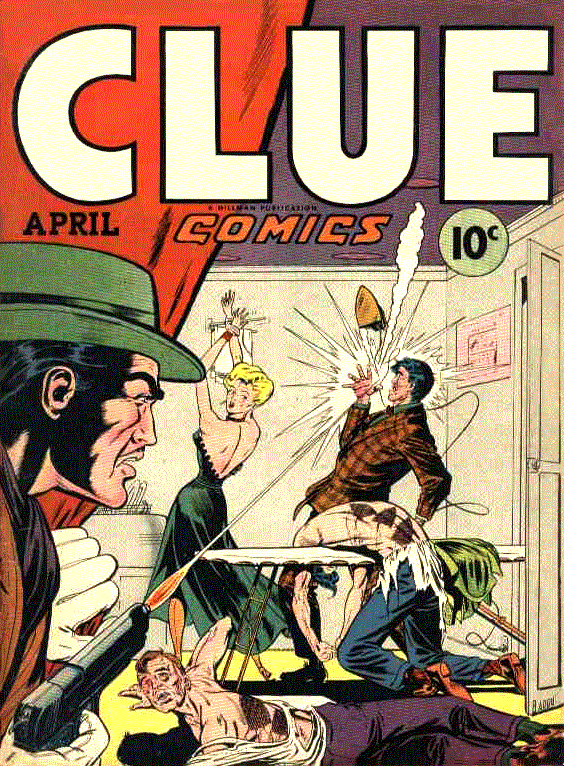|
Clue Comics 14 (Volume 2 Number 2), April 1947, cover
©Hillman Periodicals
Editor: Ed Cronin
Penciller: Dan Barry
Inks: Dan Barry
Colorist: ?
Letterer: ?
Dan Barry's cover of Clue Comics 14 lends a whole new meaning to the word "iron!" The cover illustrates, to the best of our knowledge, the feature story of the book starring the continuing character Gunmaster. Clue Comics 14
also features art by Joe Simon and Jack Kirby on two stories, and by Carmine Infantino on a third!
Graphic, lurid covers and stories such as this almost led to the demise of the comic-book industry during the 1950s. In the late 1940s the superhero craze had cooled down, and publishers
turned increasingly to other genres such as horror and the supernatural, science fiction, war, western, romance and humor. Crime comics were particularly successful from about 1946 to 1952. Meanwhile, the general
public was becoming increasingly concerned by the level of gore and violence in horror and crime comics, especially EC's very successful horror lineup. Some comics such as Fox Feature Syndicate's Murder Incorporated had
'For Adults Only' printed on the covers, which probably increased their appeal to children. Some crimes committed by children were alleged to be 'copycat' crimes. Leading the charge against horror and crime comics
was Dr. Frederick Wertham, senior psychiatrist for the New York Department of Hospitals. In 1947 Wertham began lecturing, writing articles and holding conferences about 'abnormally sexually aggressive' comic books.
Publishers banded together in July 1948 to form the Association of Comics Magazine Publishers, offering a seal of approval for comics which met the Association's standard of decency. The industry's first attempt at
self-censorship quickly foundered. Public outcry against comic books reached a peak with Wertham's publication of The Seduction of the Innocent in 1954. He compared comic books to drugs that corrupted children and led to juvenile delinquency. Unfortunately, his sensationalist book was filled with half-truths, convenient statistics and carefully cropped examples, very convincing to a public looking for a scapegoat for juvenile crime. Arguments generally followed the lines of, "Juvenile delinquents all read comic books, so comic books cause juvenile delinquency." The US Senate Subcommittee to Investigate Juvenile Delinquency in the United States held hearings in April 1954 which included Wertham's damning testimony. The Senate's report concluded, "This country cannot afford the calculated risk involved in feeding its children, through comic books, a concentrated diet of crime, horror and violence." The publishers again rushed to self-regulate their publications. The Comics Magazine Association of America Inc. formulated the Code for Editorial Matter, which saved the comics industry but nearly destroyed it in the process. While wholesome comics like Gilbertson's Classics Illustrated and Dell's entire comics line continued to be published without code approval, horror and crime comics virtually vanished. Fiction House, Eastern Color, United Features, Star Publications, Toby Press and Sterling Comics all went out of business. Most post-code comics became infantile and bland. DC and Marvel (Timely) attempted to rejuvenate the super-hero genre with limited success, and introduced a number of adventure comics to fill the void. EC's 'New Directions' line which attempted such fare as pirate tales, medical adventures, science fiction never caught on, and within a year Mad was all that remained of the company. Two years later with the publication of the first new Flash story in DC'sShowcase 4 (October 1956), the super-hero revival began and the Silver Age of Comics had arrived.
|


